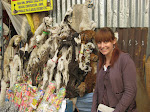At first glimpse, Sucre is dusty, hot and smoggy. ItThe fires again we´re told. We´re picked up by our young tour guide, Juan Pablo (named for the Pope who visited Sucre in 1988) and taken 15 minutes into the centre of town. The dusty first glimpses were the outter suburbs. Sucre is actually known as the White City, and once in town its easy to see why. We descend into the city and find our way through the one way streets to our hostal. Its a gorgeous place with an inner courtyard and 3 floors. True Spanish style, the rooms have been maintained to reflect what was true of the 1800s.
 We settled and had a wander around this great city. It´s a student town with it´s first univeristy (the second for South America) established in 1594. It has a small town feel, but the city limits span for kilometres, it´s much less hilly than La Paz.
We settled and had a wander around this great city. It´s a student town with it´s first univeristy (the second for South America) established in 1594. It has a small town feel, but the city limits span for kilometres, it´s much less hilly than La Paz.The next morning we head out for a city tour. Having dropped to a health 2800m, we have no problems walking the streets. We head with Juan Pablo to the parliment museum. Sucre has a colourful history. Before the executive power was taken to Laz Paz, all policital sessions were held in the spectacular courts here. Gold leaf adorns most of the seats, doors and walls along with OLD painting and mosaics. In the adjoining rooms, there are paintings of war-time generals (including the female officers) and a number of swords and other trinkets. There are also a few drawings of Sucre from the 1600s, the city has not really changed, just grown.
From here we head to the textile museum. Sucre is surrounded by some interesting communities who live much the same way now as they did in the 1600s. Stone ovens, mud brick houses and an incrredible textile tradition. The Jáqua and Terrabucco tribes are among the most famous for their unusual weaves. Although living quicte close, their styles are quite different. The Bolivian Government has been quite active in assisting these tribes to establish their textile trade for tourism.

 Their work is incredible. So intricate with months being spent on each piece. Despite the fair trade agreements, the textiles are still very reasonable, so we all purchase a small weaving.
Their work is incredible. So intricate with months being spent on each piece. Despite the fair trade agreements, the textiles are still very reasonable, so we all purchase a small weaving.Following this fabulous museum, we head to the top of the city. There´s a school that sits at the top of the city, on a flat between 2 mountains. It gives us a great view of the city. Here we stop for lunch and Juan Pablo tells us more about his city and our plans for next few days. Tommo and Juan P get stuck into a seriously interesting breadless hamburger and we all kick back to enjoy some sun.
 Our tour brings us back to the main squarte in town. Juan R suggest we use the afternoon to check out the dinosaur footprints in the north of the town. Not knowing much about it, I´m surprised to learn that Sucre has teh largest continuous wall of footprints in the world. There are hundreds. We jump onto a bus and head out of town to the site.
Our tour brings us back to the main squarte in town. Juan R suggest we use the afternoon to check out the dinosaur footprints in the north of the town. Not knowing much about it, I´m surprised to learn that Sucre has teh largest continuous wall of footprints in the world. There are hundreds. We jump onto a bus and head out of town to the site.It was discovered about 25 years ago by the nearby concrete company who sliced through the mountain, discovered it wasn´t rich with the right stuff, then called a scientist or two to looks at these strange marks on the wall. Erosion has seens the loss of some of the footprints, but there are still clear marks from carnivores, herbivores and
other lizards. The park they´ve developed around the footprints is a bit of fun. It contains life size dinosaur models (36 metres long). Its more than a little surreal.



We head home for an early night, we´re off to Portesi, a mining town 3 hours north, the next morning.
Rob opts to stay in Sucre and explore a little more.
That night, Tom discovered ´Le Ley y el Orden´ (Law and Order) on tellie. It´s now become a trip catch phrase. It´s sort of along the same vein as Dad´s misuse of the word ´bolarios´ in place of bolivianos. hehe good times.

No comments:
Post a Comment